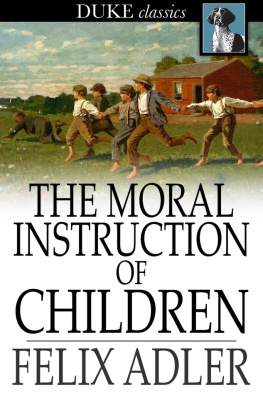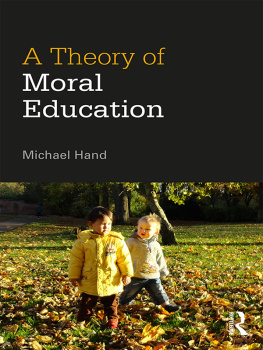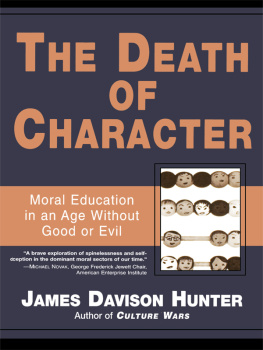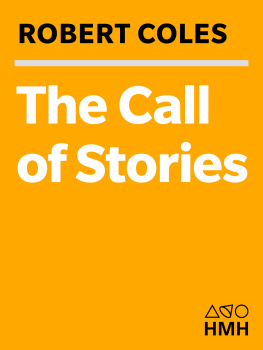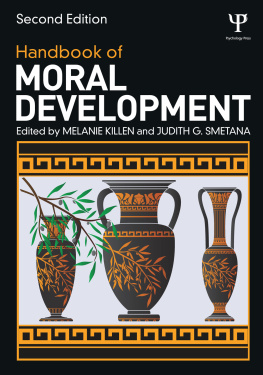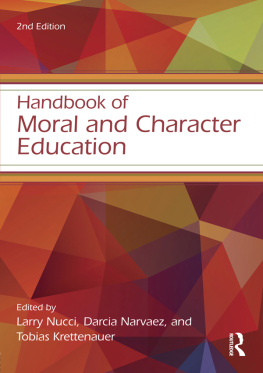Copyright 1997 by Robert Coles
All rights reserved under International and Pan-American Copyright Conventions. Published in the United States by Random House, Inc., New York, and simultaneously in Canada by Random House of Canada Limited, Toronto.
Grateful acknowledgment is made to Howard Axelrod for permission to print his story Starry Time. Reprinted by permission of Howard Axelrod.
eISBN: 978-0-307-79981-4
Random House website address: http://www.randomhouse.com/
v3.1
The mind now thinks, now acts, and each fit reproduces the other. When the artist has exhausted his materials, when the fancy no longer paints, when thoughts are no longer apprehended and books are a wearinesshe has the resources to live. Character is higher than intellect. Thinking is the function. Living is the functionary. The stream retreats to its source. A great soul will be strong to live, as well as strong to think.
RALPH WALDO EMERSON
Let us sing a new song not with our lips but with our lives.
SAINT AUGUSTINE
PREFACE

F or over thirty years I have been trying to understand how children of various backgrounds acquire their particular assumptions, beliefs, and values. Much of that work was done in homes and schools, as well as hospital wards and clinics, and has been described in books such as The Moral Life of Children (1986) and The Spiritual Life of Children (1990). Additionally, in early 1990 I worked with the Girl Scouts of America to implement a survey, done by Louis Harris and Associates, called The Beliefs and Moral Values of Americas Children. After the quantitative research was done (thousands of questionnaires were answered by young people across the nation) I began to meet with children who had answered the questionnaire in order to obtain from them, individually and in group settings, something that multiple-choice answers dont quite provide: access to the complex range of attitude, conviction, feeling, and sentiment that may inform any of the values we upholdthe ambiguities and even inconsistencies or outright contradictions that inform our opinions as we try to think of them, express them. I also began meetings with groups of those childrens parents and teachers, men and women who had brought them up, had struggled to do right and well by them, or had been teaching them. I myself am the father of three sons, and I have taught in elementary schools and high schools as a volunteer, as well as at several universities, where I have worked with undergraduates and with medical students.
In the writing just mentioned I tried to describe how various children think about moral issues, ethical and religious and spiritual questions. Here I am addressing another matter: how we as adults, as mothers and fathers and schoolteachers and friends, give shape to the values of children as expressed in their behavior, their conduct; how we encourage and instruct them to uphold in daily life one or another set of beliefs. We have heard much in recent years about literacy, about I.Q., about mental health. Books such as Cultural Literacy and The Bell Curve have reminded us that the minds cognitive activity continues to be very much a subject of interest and argument, even as Howard Gardner has tried to help us broaden the discussion by emphasizing the different aspects of that life, in Multiple Intelligences: The Theory in Practice. Moreover, for decades psychologists and psychiatrists have emphasized that cognition doesnt take place in a vacuum, that the mind is where we harbor anxieties, affections, fears, and worries as well as facts and figures; and so a book such as Daniel Golemans Emotional Intelligence has correctly struck a chord in many of us. Here, I hope to amplify further this continuing consideration of the cognitive, the psychological or emotional, by taking up the moral side of our childrens lifea third realm, as it were, of the minds activity: character as it develops from the very start of life right through adolescence.
The idea for this book began as a consequence of an article I wrote for The Chronicle of Higher Education (September 18, 1995), titled The Disparity Between Character and Intellect. I was flooded with responses to that essay (which is worked into the third part of this book). Soon enough, prodded by some of those letters, I was trying to address at greater length the issues raised in the essay, and to do so with the parents and teachers in mind whom I have met in the course of the research Ive done these past years. I thank those men and women for all Ive learned from them, and from the children theyve brought up and taught. I thank, too, Kate Medina, whose editorial assistance and guidance have been crucial to this attempt to speak directly to my fellow parents and teachers, and Amanda Urban for her constant encouragement. I thank, as well, Ed Gerwig for his knowing help with this manuscript. I also thank, not least, the four individuals to whom I dedicate this book: Ruby Bridges Hall, for everything she taught all Americans when she pioneered school desegregation in Louisiana in the early 1960s, and for all she has continued to teach us as a mother and as her very own kind of teacher now working in the New Orleans schools; Arnold Hiatt, an extraordinarily sensitive and thoughtful Massachusetts businessman; Cheryl Pickrell, an Arizona teacher of great moral energy; Larry Ronan, a Boston physician out there with the hurt, the vulnerable, the needy. Bless these four and the many like them across the nation for all they do to make this life a better one for their fellow citizens of the United States and for all their fellow human beings.
CONTENTS
I

MORAL
INTELLIGENCE

1
THE MORAL IMAGINATION: WITNESSES

T his book is about moral intelligence, about how it is enabled through the moral imagination, our gradually developed capacity to reflect upon what is right and wrong with all the emotional and intellectual resources of the human mind. This book is about what it means to be a good person, as opposed to a not-so-good person or a bad person. This book is meant to offer some thoughts on how character develops in children, how their moral imagination grows at different moments of their lives; it is meant for those who are bringing up children, teaching them. In The Moral Life of Children, I examined moral thinking, as it gets shaped by influences outside the home: by class and race, by social events, by cultural forcesschool desegregation, the presence of nuclear bombs in our midst, the particular neighborhood where a boy or girl lives, the assumptions it fosters. In this book, by contrast, I take up the issue of moral conduct, of the childs lived life, as it develops in response to the way he or she is treated at home and in school. The book aims to show how moral



